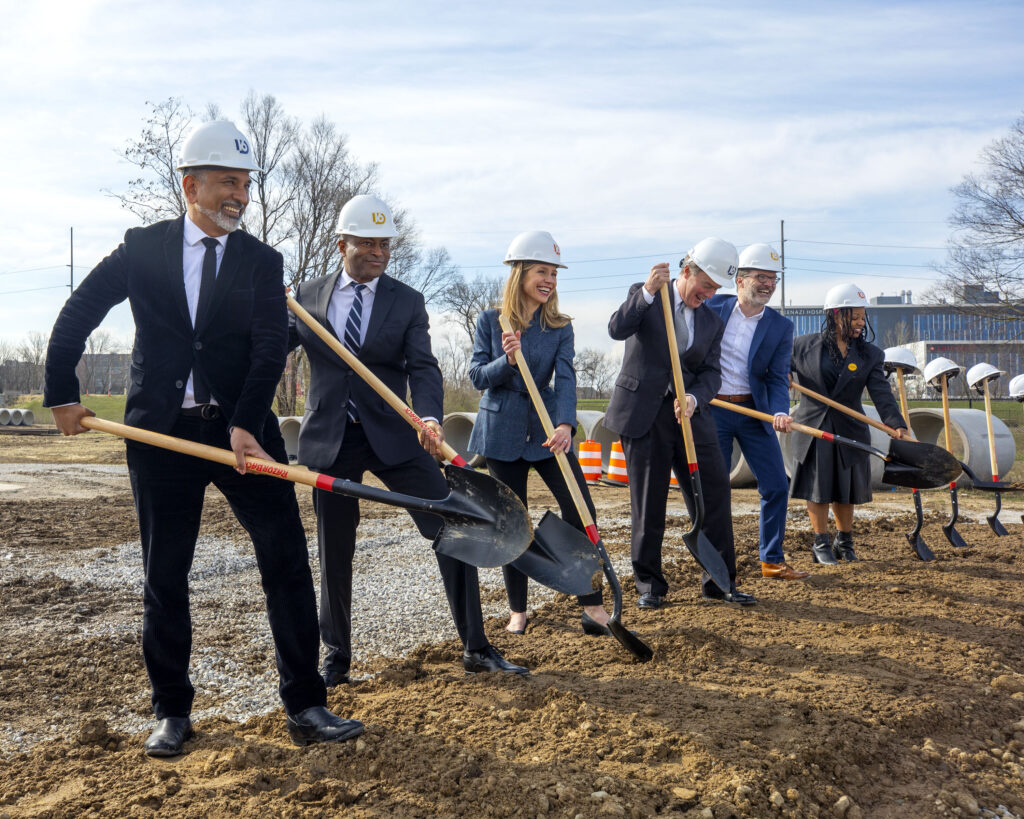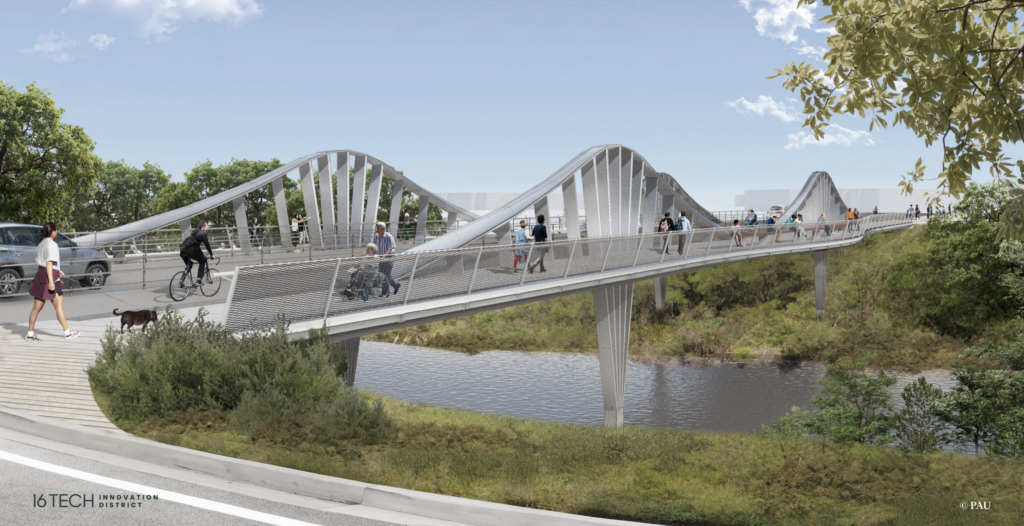Today, 16 Tech Community Corporation, the nonprofit responsible for the programmatic and physical development of 16 Tech Innovation District, broke ground on a new community bridge, spanning Indianapolis’ Fall Creek at West 10th Street and Riley Hospital Drive to connect the 16 Tech Innovation District to Indianapolis’ research and medical corridor.
Local leaders Mayor Joe Hogsett, City-County Council President, District 11, Vop Osili, along with 16 Tech’s President & CEO Emily Krueger, and the design and engineering firms sbp and PAU welcomed guests to announce the start of construction on a first-of-its-kind bridge. They were joined by neighborhood and community stakeholders, including Ebony Chappel of Friends of Belmont Beach.
The bridge, linking 16 Tech Innovation District and the city’s wider trail and greenway network, including the Indianapolis Cultural Trail: A Legacy of Gene & Marian Glick, is scheduled to be complete by summer of 2024.
The international multi-disciplinary team of sbp, PAU, Moniteurs Communication Design, Martha Schwartz Partners (MSP), Shrewsberry & Associates, CTL Engineering, Circle Design Group and People for Urban Progress (PUP) were charged with designing a signature work of public infrastructure that will serve as an example of innovation and collaboration for Indianapolis.
This new structure prioritizes accessibility, pedestrians and cyclists by creating protected pathways separated from vehicular traffic with more than half of its square footage dedicated to non-vehicular use. The innovative structure reinterprets the principles of a classic suspension bridge using flat steel plates and fan-type masts to create an entirely new form.
“A community effort and vision, the 16 Tech bridge is not only an iconic piece of architecture for the city of Indianapolis, but a representation of shared values around inclusivity and accessibility,” said Krueger, President & CEO, 16 Tech Community Corporation. “In addition to its physically connectivity the bridge connects talent – neighbors, entrepreneurs, researchers, students – to the resources and programs in the 16 Tech Innovation District that will help them scale and grow companies.”
“The 16 Tech bridge not only provides a link to a thriving innovation district, but it also provides a connection to a more bike-and-pedestrian-friendly Indianapolis infrastructure system,” said Mayor Joe Hogsett. “The City is proud to have supported 16 Tech with $55 million in infrastructure investments since 2016, and this first-of-its-kind bridge represents a continuation of our mutual commitment to cutting-edge place that contributes to a prosperous City.”
As part of the design process, the team spent six months in 2021 engaging local residents, with a special focus on the near West and near Northwest neighborhoods of Indianapolis. The team collected input from residents through online surveys, virtual meetings, a hotline in English and Spanish, site walks, neighborhood canvassing and a partnership with a local STEM-based school. A local advisory committee of Indianapolis residents and civic leaders helped shape the community engagement process, which informed the final bridge design.
“The design team is thrilled to see this innovative and ambitious bridge come to life,” said Michael Stein, Partner and Managing Director of sbp’s New York office. “The creativity embodied in this project is a product of our collaborative design approach with PAU and the rest of the team, 16 Tech’s unwavering support for a landmark structure, and feedback from a thoughtful and engaged community. We look forward to the bridge’s completion next year when Indianapolis can enjoy this iconic new crossing.”
The signature wave-like design is the result of one of the bridge’s most significant and inventive features, its reinterpretation of the principles of a classic suspension bridge to create an entirely new form. This feat of engineering is accomplished by replacing the large vertical masts found on a typical suspension bridge with a fan-type arrangement of multiple smaller masts. Flat steel plates replace the traditional suspension cables as the main supports. The bridge’s tension element is allowed to follow the new mast arrangement. The resulting structure acts like a suspension bridge but is an entirely new approach to the genre. When built, this unique design will become the first of its kind in the United States.
“We’re thrilled to have collaborated with sbp on this forward-thinking bridge for 16 Tech and greater Indianapolis, which is not only structurally innovative, but also serves as an important infrastructural prototype for sustainable city design,” said PAU Founder and Creative Director Vishaan Chakrabarti. “By prioritizing pedestrian and bicycle traffic while also emulating the trees of Fall Creek, the bridge represents a stride towards achieving a more carbon neutral city, while functioning as a prominent connector that brings greater awareness of Indianapolis’ complex network of outdoor hiking trails and pathways.”
Design and construction of the 16 Tech bridge are supported through funding from the City ofIndianapolis and a $38 million grant from Lilly Endowment Inc., that included support for public infrastructure and the operations of 16 Tech Community Corporation.
While the bridge itself is fully-funded, 16 Tech Community Corporation is seeking a community partner to honor the bridge and its connection to nearby neighborhoods through a naming sponsorship that will provide long-term maintenance for the bridge as well as support remaining infrastructure in the district.
“In the spirit of creativity and collaboration, 16 Tech is excited to continue conversations with partners who share our vision of the bridge as a community asset,” said Krueger.


